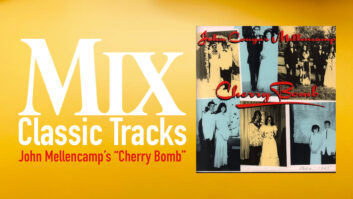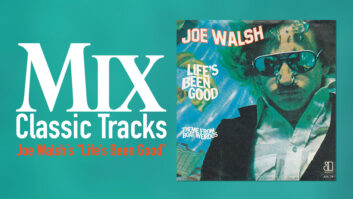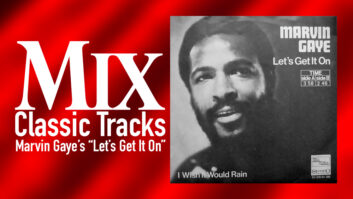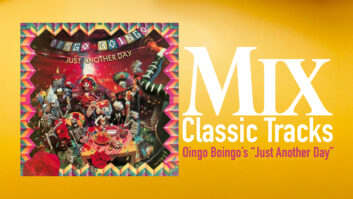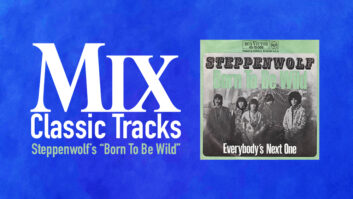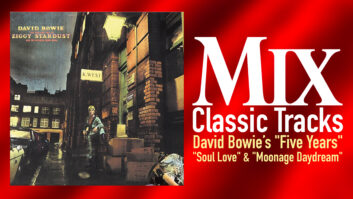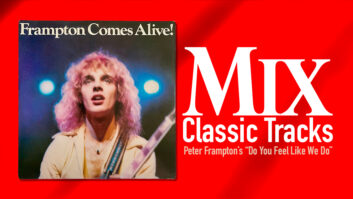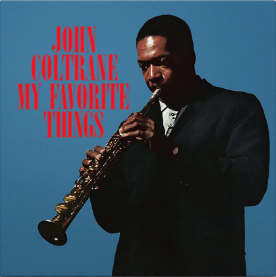 The songwriting credit belongs to Richard Rodgers and Oscar Hammerstein II, who penned the song for their immortal 1959 Broadway musical, The Sound of Music. It was sung by Mary Martin onstage and on the original cast album, which was Number One on the Billboard charts for 16 weeks in 1960, and in the Top 200 for six years. Recent generations probably know “My Favorite Things” from the 1965 film of The Sound of Music-can’t you picture Julie Andrews cheerily warbling the first line: “Raindrops and roses and whiskers on kittens”? But to jazz-lovers everywhere, “My Favorite Things” has always belonged to the great post-war saxophone titan John Coltrane. At 13 minutes, 41 seconds in length, his original recorded version of the song, tracked October 21, 1960, at Atlantic Studios in New York, goes places even the world-traveling Von Trapp family (who inspired The Sound of Music) never dreamed of. It was a pivotal moment in Coltrane’s ascendancy to the peak of jazz’s Mount Olympus, and one of the great performances in modern American music. It was produced by Nesuhi Ertegun and recorded by TEC Hall of Fame Award inductee, Tom Dowd, along with Phil Iehle.
The songwriting credit belongs to Richard Rodgers and Oscar Hammerstein II, who penned the song for their immortal 1959 Broadway musical, The Sound of Music. It was sung by Mary Martin onstage and on the original cast album, which was Number One on the Billboard charts for 16 weeks in 1960, and in the Top 200 for six years. Recent generations probably know “My Favorite Things” from the 1965 film of The Sound of Music-can’t you picture Julie Andrews cheerily warbling the first line: “Raindrops and roses and whiskers on kittens”? But to jazz-lovers everywhere, “My Favorite Things” has always belonged to the great post-war saxophone titan John Coltrane. At 13 minutes, 41 seconds in length, his original recorded version of the song, tracked October 21, 1960, at Atlantic Studios in New York, goes places even the world-traveling Von Trapp family (who inspired The Sound of Music) never dreamed of. It was a pivotal moment in Coltrane’s ascendancy to the peak of jazz’s Mount Olympus, and one of the great performances in modern American music. It was produced by Nesuhi Ertegun and recorded by TEC Hall of Fame Award inductee, Tom Dowd, along with Phil Iehle.
Born in North Carolina in 1926, John Coltrane showed an early love and aptitude for music (his father played several instruments). His first instrument was the E-flat horn, followed by the clarinet, but by high school he had switched to alto saxophone (his main early influences were Johnny Hodges, best known for his long career with Duke Ellington, and R&B honker Tab Smith). He studied music at a pair of Philadelphia schools-Granoff Studios and the Ornstein School of Music-and while there he landed a job in Jimmy Heath’s big band. In 1947 he was hired by blues/R&B jazz singer Eddie “Cleanhead” Vinson to be a tenor player, which opened him up to a new range of influences, including Ben Webster, Coleman Hawkins and Lester Young. His first recorded work came as an alto player in Dizzy Gillespie’s group in the early ’50s. By 1955 he was a member of the Miles Davis Quintet, and it is in that unit that he truly came into his own, appearing on a number of classic recordings, including “‘Round Midnight.”
A master of both melody and rhythm, Coltrane quickly showed that he had both the imagination and the musical chops to take the saxophone into some new realms. He once explained to fellow saxophonist Wayne Shorter that part of his approach to soloing was to start in the middle of a sentence and then try to go both directions at once, but it wasn’t nearly as haphazard as that explanation sounds. He was always keenly aware of where he was headed, and he had the compositional acumen and fluid dexterity to push his solos in any direction he desired. People who don’t know the breadth of Coltrane’s career tend to think of him as the man who popularized screeching saxophone-his dense musical assaults were described by one writer at the time as “sheets of sound”-but Coltrane also had a lyrical side unmatched by any of his contemporaries.
After two years with Miles, Coltrane struck out on his own, collaborating with Thelonious Monk (“Monk’s Mood,” “Tinkle, Tinkle,” et. al.), Art Blakey, Mal Waldron and Johnny Griffin. By 1958, though, he had rejoined Miles’ group and was a vital part of Davis’ groundbreaking modal jazz experiment, Kind of Blue. Around the same time, he began cutting albums as a leader (Blue Trane was the first to show his growing skill as a composer), and that led to his being signed by Atlantic Records, where the Turkish brothers Ahmet and Nesuhi Ertegun were building a reputation for putting out high-quality jazz and R&B. By 1960, Coltrane was hanging out with L.A. “free jazz” rebels such as Ornette Coleman, Don Cherry and Eric Dolphy while also laying the groundwork for his great ’60s quartet: Coltrane, pianist McCoy Tyner, bassist Jimmy Garrison and drummer Elvin Jones. (Steve Davis played bass on the sessions for My Favorite Things.)
According to Dowd, by the time he first worked with Coltrane, on 1960’s Giant Steps, “I was feeling pretty comfortable in the studio, [which he’d helped build and equip a few years earlier] and I’d gained a lot of confidence in what I was doing. All of a sudden I’m told we’re doing Coltrane and I have to do a setup: ‘Oh, it’s a quartet or quintet, whatever. Fine, yeah, yeah.’ I’d heard him, of course, and I knew who he was, but I’m kind of dismissing it. And this gentleman shows up, I daresay, an hour-and-a-half, two hours before the session and says, ‘May I rehearse?’ I say ‘Sure.’ I have everything all set up and I’m doing something else-I don’t know, I’m preoccupied with mastering or editing something The Clovers did; I don’t know. And I look over my shoulder and here’s this solitary figure standing in the corner playing scales and then changing his mouthpiece and then changing instruments. I’m thinking, ‘Hey, this guy knows what the hell he’s doing. He’s really got something going! I’m impressed with his demeanor and his approach.
“As the other musicians started trickling in, they would be listening to him practice, learning from him. And he might have been sensitive to their being there, but he wasn’t letting it interfere with his train of thought. He’s not saying anything. He’s just minding his own business, doing what he has to do to prepare to record. He wasn’t a guy who would say, ‘All right men, this is what we’re going to do!’ But when he finally said, ‘I want to play this or that song’ and the musicians start comping, I realize, ‘Hey, man, they blotted up where he was coming from.’ He didn’t have to say much. All I had to do was capture what the hell they were doing.”
Coltrane-nearly all jazz players, in fact-cut entirely live in the studio, occasionally taking two or three different passes at a tune, but sometimes playing something only once. Since jazz is by nature an improvisational medium, the takes often differed considerably, and so usually the producer (at Atlantic that was Nesuhi Ertegun) in conjunction with the artist, would choose the take they liked best. Atlantic was a good room for live jazz-big enough to provide some ambience for an ensemble of almost any size, and well-equipped by Dowd and Phil Iehle.
“When I was doing Coltrane, we were using the eight-position 2-track custom console I’d built,” Dowd recalls, “and I was feeding a stereo and a mono machine simultaneously. When we were doing jazz stuff we had to be able to record it mono, too, because there were still so many mono players out there; in fact, it was still mostly mono. Both the mono and the stereo were Ampexes-the mono would have been a 300, the 2-track machine a 352.”
Dowd says he always liked to have the musicians in good visual contact with each other, “and I didn’t worry much about bleed. It was a live performance so it’s not like we were going to go in and do a bunch of fixes.” By 1960, Dowd notes, “we were using a lot of the great German microphones. We had [Neumann] 47s, 48s, 49s, along with the 639. I also had an EL251. Usually I had a 48 or 49 on John. Usually the bass mic was some form of Electro-Voice, a 666 or 667, because I was working deals with them and they were giving me microphones to experiment with. For Elvin I might use as many as three microphones, but it depended on how he was playing whether I used all three or just the overhead-a 47-or the two down low, which were probably those Western Electric dynamic ‘salt shaker’ jobs.
“That group fit the room perfectly,” he continues. “Dynamically, they couldn’t play too loud to ever menace the room or make the room sing or jump. They couldn’t saturate the room. I always had fun recording them.”
It’s hard to say what it was about “My Favorite Things” that struck such a responsive chord in the listening public, but it was an immediate success. Perhaps it was that magical blending of the familiar, popular theme with the quartet’s fanciful solo flights-Tyner’s elegant block chords; Jones’ effortless rhythmic touch; Davis’ steady but assertive bass underpinning; and Coltrane, playing the then-rarely used soprano sax, soaring like some great colorful bird, challenging himself, his band and all of us. The song became Coltrane’s signature tune. It was the anchor for the popular album of the same name-the other three cuts were beautifully interpreted standards by Cole Porter (“Every Time We Say Good-bye”) and George Gershwin (“Summertime” and “But Not for Me”)-and it became a springboard for a series of even more exciting musical adventures Coltrane would embark on during the last seven years of his life. “I’ve got to keep experimenting,” Coltrane said in the liner notes for My Favorite Things. “I feel that I’m just beginning. I have part of what I’m looking for in my grasp, but not all.” Looming just up the road were Africa Brass, A Love Supreme, Ascension and so much more. It’s never too late to start chasing this ‘Trane.
